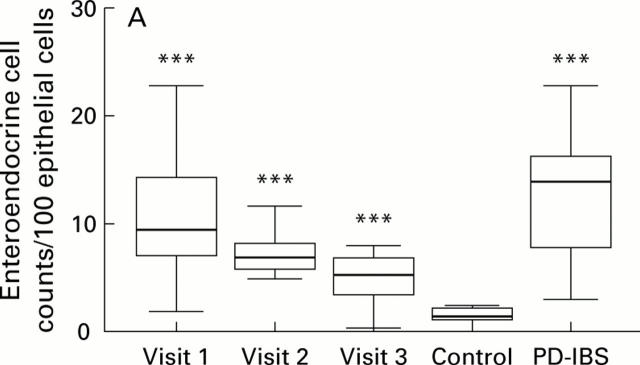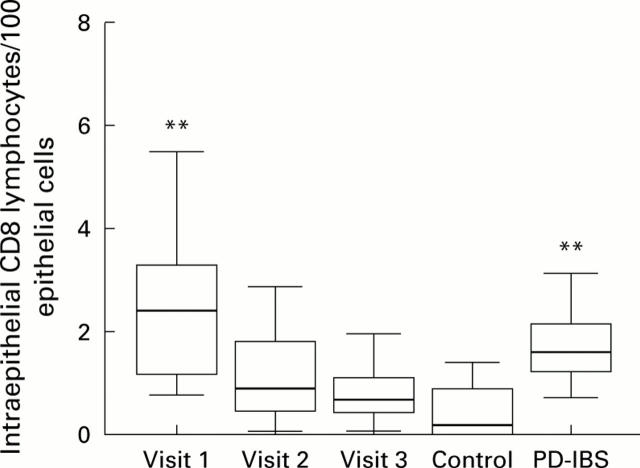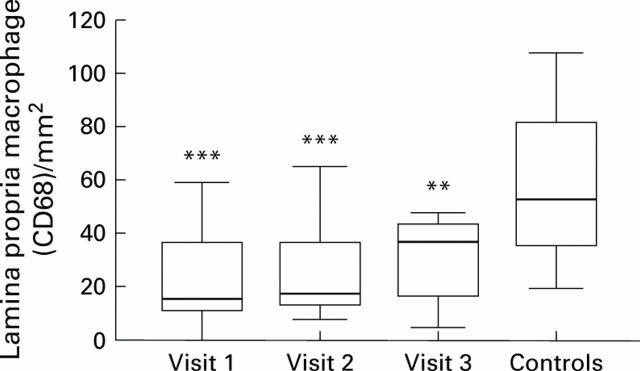Abstract
BACKGROUND AND AIMS—Post-dysenteric irritable bowel syndrome (PD-IBS) develops in up to 25% of patients following Campylobacter enteritis. Our aim was to define the pathological basis of this subgroup of IBS. METHODS—Twenty one patients (group 1) underwent serial rectal biopsy and gut permeability testing following acute Campylobacter enteritis as did 10 PD-IBS patients (group 2) and 12 asymptomatic controls. RESULTS—In group 1, enteroendocrine cell (EC) numbers were markedly increased initially and at six and 12 weeks (p<0.001) compared with controls. Gut permeability, as assessed by the lactulose/mannitol ratio, was significantly elevated, initially and at 12 weeks (p<0.005). CD3, CD4, and CD8 lymphocyte counts in the lamina propria and intraepithelial lymphocytes (IEL) were significantly increased initially compared with controls. At visit 1, EC numbers were positively correlated with CD3 counts (r=0.6, p=0.01). At one year, seven subjects (five with persistent loose stools) had rectal biopsies which showed significantly elevated EC, CD3, and IEL counts. In group 2, EC and IEL counts were significantly increased compared with controls (p<0.001), as was gut permeability (p<0.01). CONCLUSION—Increased EC, T lymphocytes, and gut permeability are acute changes following Campylobacter enteritis which can persist for more than a year and may contribute to PD-IBS. Keywords: irritable bowel syndrome; Campylobacter; enteroendocrine cell; T lymphocytes
Full Text
The Full Text of this article is available as a PDF (178.0 KB).
Figure 1 .

(A) Enteroendocrine cell counts per 100 epithelial cells in the patient cohort at visits 1, 2, and 3 compared with controls and post-dysenteric irritable bowel syndrome (PD-IBS) patients. ***Significantly increased compared with controls, p<0.001. Values at visits 2 and 3 were significantly lower than those at visit 1, p<0.05. (B) Rectal biopsy stained for synaptophysin showing increased numbers of enteroendocrine cells in the colonic crypt base of a patient three weeks after infection with Campylobacter jejuni. A control biopsy is shown (C) for comparison. Original magnification: ×40. Synaptophysin positive cells are brown, with blue haematoxylin counterstain. CD3, CD4, and CD8 lamina propria lymphocyte counts (table 5)
Figure 2 .
CD3 staining lamina propria lymphocytes. ***p<0.001 v controls. Values at visit 3 were significantly less than those at visit 1, p<0.005
Figure 3 .
Intraepithelial lymphocytes stained for the CD8 marker. **Significantly elevated compared with controls. Differences from control were no longer significant at visits 2 and 3. Post-dysenteric irritable bowel syndrome (PD-IBS) patients also showed significant increases.
Figure 4 .
Macrophages counts (CD68 positive) showed a marked decline at visit 1. ***p<0.001, **p<0.005 v controls.
Selected References
These references are in PubMed. This may not be the complete list of references from this article.
- Adrian T. E., Ferri G. L., Bacarese-Hamilton A. J., Fuessl H. S., Polak J. M., Bloom S. R. Human distribution and release of a putative new gut hormone, peptide YY. Gastroenterology. 1985 Nov;89(5):1070–1077. doi: 10.1016/0016-5085(85)90211-2. [DOI] [PubMed] [Google Scholar]
- Bearcroft C. P., Perrett D., Farthing M. J. 5-hydroxytryptamine release into human jejunum by cholera toxin. Gut. 1996 Oct;39(4):528–531. doi: 10.1136/gut.39.4.528. [DOI] [PMC free article] [PubMed] [Google Scholar]
- Bearcroft C. P., Perrett D., Farthing M. J. Postprandial plasma 5-hydroxytryptamine in diarrhoea predominant irritable bowel syndrome: a pilot study. Gut. 1998 Jan;42(1):42–46. doi: 10.1136/gut.42.1.42. [DOI] [PMC free article] [PubMed] [Google Scholar]
- Beubler E., Horina G. 5-HT2 and 5-HT3 receptor subtypes mediate cholera toxin-induced intestinal fluid secretion in the rat. Gastroenterology. 1990 Jul;99(1):83–89. doi: 10.1016/0016-5085(90)91233-v. [DOI] [PubMed] [Google Scholar]
- Bilchik A. J., Hines O. J., Zinner M. J., Adrian T. E., Berger J. J., Ashley S. W., McFadden D. W. Peptide YY augments postprandial small intestinal absorption in the conscious dog. Am J Surg. 1994 Jun;167(6):570–574. doi: 10.1016/0002-9610(94)90100-7. [DOI] [PubMed] [Google Scholar]
- Brown D. R. Mucosal protection through active intestinal secretion: neural and paracrine modulation by 5-hydroxytryptamine. Behav Brain Res. 1996;73(1-2):193–197. doi: 10.1016/0166-4328(96)00095-2. [DOI] [PubMed] [Google Scholar]
- CHAUDHARY N. A., TRUELOVE S. C. The irritable colon syndrome. A study of the clinical features, predisposing causes, and prognosis in 130 cases. Q J Med. 1962 Jul;31:307–322. [PubMed] [Google Scholar]
- Calam J., Ghatei M. A., Domin J., Adrian T. E., Myszor M., Gupta S., Tait C., Bloom S. R. Regional differences in concentrations of regulatory peptides in human colon mucosal biopsy. Dig Dis Sci. 1989 Aug;34(8):1193–1198. doi: 10.1007/BF01537267. [DOI] [PubMed] [Google Scholar]
- Cobden I., Rothwell J., Axon A. T. Intestinal permeability and screening tests for coeliac disease. Gut. 1980 Jun;21(6):512–518. doi: 10.1136/gut.21.6.512. [DOI] [PMC free article] [PubMed] [Google Scholar]
- Cobden I., Rothwell J., Axon A. T. Intestinal permeability and screening tests for coeliac disease. Gut. 1980 Jun;21(6):512–518. doi: 10.1136/gut.21.6.512. [DOI] [PMC free article] [PubMed] [Google Scholar]
- Cong Y., Brandwein S. L., McCabe R. P., Lazenby A., Birkenmeier E. H., Sundberg J. P., Elson C. O. CD4+ T cells reactive to enteric bacterial antigens in spontaneously colitic C3H/HeJBir mice: increased T helper cell type 1 response and ability to transfer disease. J Exp Med. 1998 Mar 16;187(6):855–864. doi: 10.1084/jem.187.6.855. [DOI] [PMC free article] [PubMed] [Google Scholar]
- Delvaux M., Louvel D., Mamet J. P., Campos-Oriola R., Frexinos J. Effect of alosetron on responses to colonic distension in patients with irritable bowel syndrome. Aliment Pharmacol Ther. 1998 Sep;12(9):849–855. doi: 10.1046/j.1365-2036.1998.00375.x. [DOI] [PubMed] [Google Scholar]
- Fernandez-Prada C. M., Hoover D. L., Tall B. D., Venkatesan M. M. Human monocyte-derived macrophages infected with virulent Shigella flexneri in vitro undergo a rapid cytolytic event similar to oncosis but not apoptosis. Infect Immun. 1997 Apr;65(4):1486–1496. doi: 10.1128/iai.65.4.1486-1496.1997. [DOI] [PMC free article] [PubMed] [Google Scholar]
- Fiocchi C. Inflammatory bowel disease: etiology and pathogenesis. Gastroenterology. 1998 Jul;115(1):182–205. doi: 10.1016/s0016-5085(98)70381-6. [DOI] [PubMed] [Google Scholar]
- Groux H., O'Garra A., Bigler M., Rouleau M., Antonenko S., de Vries J. E., Roncarolo M. G. A CD4+ T-cell subset inhibits antigen-specific T-cell responses and prevents colitis. Nature. 1997 Oct 16;389(6652):737–742. doi: 10.1038/39614. [DOI] [PubMed] [Google Scholar]
- Gwee K. A., Graham J. C., McKendrick M. W., Collins S. M., Marshall J. S., Walters S. J., Read N. W. Psychometric scores and persistence of irritable bowel after infectious diarrhoea. Lancet. 1996 Jan 20;347(8995):150–153. doi: 10.1016/s0140-6736(96)90341-4. [DOI] [PubMed] [Google Scholar]
- Gwee K. A., Leong Y. L., Graham C., McKendrick M. W., Collins S. M., Walters S. J., Underwood J. E., Read N. W. The role of psychological and biological factors in postinfective gut dysfunction. Gut. 1999 Mar;44(3):400–406. doi: 10.1136/gut.44.3.400. [DOI] [PMC free article] [PubMed] [Google Scholar]
- Harvey R. F., Mauad E. C., Brown A. M. Prognosis in the irritable bowel syndrome: a 5-year prospective study. Lancet. 1987 Apr 25;1(8539):963–965. doi: 10.1016/s0140-6736(87)90304-7. [DOI] [PubMed] [Google Scholar]
- Heaton K. W., O'Donnell L. J., Braddon F. E., Mountford R. A., Hughes A. O., Cripps P. J. Symptoms of irritable bowel syndrome in a British urban community: consulters and nonconsulters. Gastroenterology. 1992 Jun;102(6):1962–1967. doi: 10.1016/0016-5085(92)90320-x. [DOI] [PubMed] [Google Scholar]
- Jenkins D., Balsitis M., Gallivan S., Dixon M. F., Gilmour H. M., Shepherd N. A., Theodossi A., Williams G. T. Guidelines for the initial biopsy diagnosis of suspected chronic idiopathic inflammatory bowel disease. The British Society of Gastroenterology Initiative. J Clin Pathol. 1997 Feb;50(2):93–105. doi: 10.1136/jcp.50.2.93. [DOI] [PMC free article] [PubMed] [Google Scholar]
- Jenkins D., Wakelin D. Immunoepidemiology of intestinal helminth infections. 4. Immunopathology in trichuriasis: lessons from the mouse model. Trans R Soc Trop Med Hyg. 1994 May-Jun;88(3):269–273. doi: 10.1016/0035-9203(94)90074-4. [DOI] [PubMed] [Google Scholar]
- Khoo U. Y., Proctor I. E., Macpherson A. J. CD4+ T cell down-regulation in human intestinal mucosa: evidence for intestinal tolerance to luminal bacterial antigens. J Immunol. 1997 Apr 15;158(8):3626–3634. [PubMed] [Google Scholar]
- Kyösola K., Penttilä O., Salaspuro M. Rectal mucosal adrenergic innervation and enterochromaffin cells in ulcerative colitis and irritable colon. Scand J Gastroenterol. 1977;12(3):363–367. doi: 10.3109/00365527709180942. [DOI] [PubMed] [Google Scholar]
- Lazenby A. J., Yardley J. H., Giardiello F. M., Jessurun J., Bayless T. M. Lymphocytic ("microscopic") colitis: a comparative histopathologic study with particular reference to collagenous colitis. Hum Pathol. 1989 Jan;20(1):18–28. doi: 10.1016/0046-8177(89)90198-6. [DOI] [PubMed] [Google Scholar]
- Li Y., Yio X. Y., Mayer L. Human intestinal epithelial cell-induced CD8+ T cell activation is mediated through CD8 and the activation of CD8-associated p56lck. J Exp Med. 1995 Oct 1;182(4):1079–1088. doi: 10.1084/jem.182.4.1079. [DOI] [PMC free article] [PubMed] [Google Scholar]
- Mahida Y. R., Makh S., Hyde S., Gray T., Borriello S. P. Effect of Clostridium difficile toxin A on human intestinal epithelial cells: induction of interleukin 8 production and apoptosis after cell detachment. Gut. 1996 Mar;38(3):337–347. doi: 10.1136/gut.38.3.337. [DOI] [PMC free article] [PubMed] [Google Scholar]
- Maxton D. G., Morris J., Whorwell P. J. Selective 5-hydroxytryptamine antagonism: a role in irritable bowel syndrome and functional dyspepsia? Aliment Pharmacol Ther. 1996 Aug;10(4):595–599. doi: 10.1046/j.1365-2036.1996.30172000.x. [DOI] [PubMed] [Google Scholar]
- McKendrick M. W., Read N. W. Irritable bowel syndrome--post salmonella infection. J Infect. 1994 Jul;29(1):1–3. doi: 10.1016/s0163-4453(94)94871-2. [DOI] [PubMed] [Google Scholar]
- Neal K. R., Hebden J., Spiller R. Prevalence of gastrointestinal symptoms six months after bacterial gastroenteritis and risk factors for development of the irritable bowel syndrome: postal survey of patients. BMJ. 1997 Mar 15;314(7083):779–782. doi: 10.1136/bmj.314.7083.779. [DOI] [PMC free article] [PubMed] [Google Scholar]
- Pearson A. D., Eastham E. J., Laker M. F., Craft A. W., Nelson R. Intestinal permeability in children with Crohn's disease and coeliac disease. Br Med J (Clin Res Ed) 1982 Jul 3;285(6334):20–21. doi: 10.1136/bmj.285.6334.20. [DOI] [PMC free article] [PubMed] [Google Scholar]
- Pearson A. D., Eastham E. J., Laker M. F., Craft A. W., Nelson R. Intestinal permeability in children with Crohn's disease and coeliac disease. Br Med J (Clin Res Ed) 1982 Jul 3;285(6334):20–21. doi: 10.1136/bmj.285.6334.20. [DOI] [PMC free article] [PubMed] [Google Scholar]
- Playford R. J., Domin J., Beacham J., Parmar K. B., Tatemoto K., Bloom S. R., Calam J. Preliminary report: role of peptide YY in defence against diarrhoea. Lancet. 1990 Jun 30;335(8705):1555–1557. doi: 10.1016/0140-6736(90)91378-n. [DOI] [PubMed] [Google Scholar]
- Rodríguez L. A., Ruigómez A. Increased risk of irritable bowel syndrome after bacterial gastroenteritis: cohort study. BMJ. 1999 Feb 27;318(7183):565–566. doi: 10.1136/bmj.318.7183.565. [DOI] [PMC free article] [PubMed] [Google Scholar]
- Rugtveit J., Brandtzaeg P., Halstensen T. S., Fausa O., Scott H. Increased macrophage subset in inflammatory bowel disease: apparent recruitment from peripheral blood monocytes. Gut. 1994 May;35(5):669–674. doi: 10.1136/gut.35.5.669. [DOI] [PMC free article] [PubMed] [Google Scholar]
- Sanger G. J. 5-Hydroxytryptamine and functional bowel disorders. Neurogastroenterol Motil. 1996 Dec;8(4):319–331. doi: 10.1111/j.1365-2982.1996.tb00270.x. [DOI] [PubMed] [Google Scholar]
- Savage A. P., Adrian T. E., Carolan G., Chatterjee V. K., Bloom S. R. Effects of peptide YY (PYY) on mouth to caecum intestinal transit time and on the rate of gastric emptying in healthy volunteers. Gut. 1987 Feb;28(2):166–170. doi: 10.1136/gut.28.2.166. [DOI] [PMC free article] [PubMed] [Google Scholar]
- Sjölund K., Alumets J., Berg N. O., Håkanson R., Sundler F. Enteropathy of coeliac disease in adults: increased number of enterochromaffin cells the duodenal mucosa. Gut. 1982 Jan;23(1):42–48. doi: 10.1136/gut.23.1.42. [DOI] [PMC free article] [PubMed] [Google Scholar]
- Steadman C. J., Talley N. J., Phillips S. F., Zinsmeister A. R. Selective 5-hydroxytryptamine type 3 receptor antagonism with ondansetron as treatment for diarrhea-predominant irritable bowel syndrome: a pilot study. Mayo Clin Proc. 1992 Aug;67(8):732–738. doi: 10.1016/s0025-6196(12)60797-6. [DOI] [PubMed] [Google Scholar]
- Swain M. G., Agro A., Blennerhassett P., Stanisz A., Collins S. M. Increased levels of substance P in the myenteric plexus of Trichinella-infected rats. Gastroenterology. 1992 Jun;102(6):1913–1919. doi: 10.1016/0016-5085(92)90313-n. [DOI] [PubMed] [Google Scholar]
- Talley N. J. Review article: 5-hydroxytryptamine agonists and antagonists in the modulation of gastrointestinal motility and sensation: clinical implications. Aliment Pharmacol Ther. 1992 Jun;6(3):273–289. doi: 10.1111/j.1365-2036.1992.tb00050.x. [DOI] [PubMed] [Google Scholar]
- Vermillion D. L., Ernst P. B., Collins S. M. T-lymphocyte modulation of intestinal muscle function in the Trichinella-infected rat. Gastroenterology. 1991 Jul;101(1):31–38. doi: 10.1016/0016-5085(91)90456-u. [DOI] [PubMed] [Google Scholar]
- Weigert N., Schaffer K., Schusdziarra V., Classen M., Schepp W. Gastrin secretion from primary cultures of rabbit antral G cells: stimulation by inflammatory cytokines. Gastroenterology. 1996 Jan;110(1):147–154. doi: 10.1053/gast.1996.v110.pm8536851. [DOI] [PubMed] [Google Scholar]
- Weston A. P., Biddle W. L., Bhatia P. S., Miner P. B., Jr Terminal ileal mucosal mast cells in irritable bowel syndrome. Dig Dis Sci. 1993 Sep;38(9):1590–1595. doi: 10.1007/BF01303164. [DOI] [PubMed] [Google Scholar]
- von der Ohe M. R., Camilleri M., Kvols L. K. A 5HT3 antagonist corrects the postprandial colonic hypertonic response in carcinoid diarrhea. Gastroenterology. 1994 May;106(5):1184–1189. doi: 10.1016/0016-5085(94)90008-6. [DOI] [PubMed] [Google Scholar]
- von der Ohe M. R., Camilleri M., Kvols L. K., Thomforde G. M. Motor dysfunction of the small bowel and colon in patients with the carcinoid syndrome and diarrhea. N Engl J Med. 1993 Oct 7;329(15):1073–1078. doi: 10.1056/NEJM199310073291503. [DOI] [PubMed] [Google Scholar]






